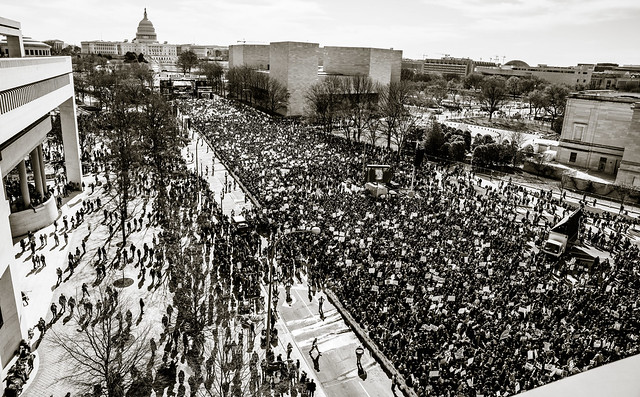
Protests in the age of social media: How was The March For Our Lives Movement shaped by social media?
Picture: Victoria Pickering (Flickr)
By Jenny Teward
After the horrific shooting of seventeen people, many of whom were students, at Marjory Stoneman Douglas High School in Parkland, Florida on February 14, 2018, fellow students of the victims along with an estimated 800,000 other people came together in Washington D.C., as well as in more than 830 places worldwide, for the March For Our Lives protest on 24th March 2018. The role of social media in this movement cannot be understated in both the mobilization and global reach of the March For Our Lives. It has now 448,000 followers on Twitter alone, so it is clear that social media provided the movement with a huge platform on which it was able to mobilize a protest with mass support.
A network movement.
When looking at the ways in which social media helped to shape the March For Our Lives movement, we can view this movement as a ‘network movement’ (Manuel Castells p. 171), as social media allowed this movement to be viewed on a global platform. Through providing survivors of the parkland shooting a platform on which they could share their experience and views on gun control, social media allowed survivors such as Emma González to connect with other victims of gun violence. Furthermore, social media also made those who had not experienced it aware of what the survivors were going through, thus allowing the movement to gain support as social media enabled people to have a much better understanding of the Parkland shooting itself as well as the motivation behind the movement.
Social media can be seen to have given the movement a sense of collective identity as those behind the March For Our Lives were able to join and speak with one collective voice, thus giving the movement a greater impact as the activists were able to use one platform to mobilize support much more successfully. The use of social media in gathering support for movements such as the March For Our Lives was extremely successful, as the large platform that social media provides allows people who would have otherwise been disengaged with causes such as gun control to engage with the issue. This then further helps movements both online, as studies have shown a positive relationship between the frequency of social media use and protest behaviour, and offline (Sebastián Valenzuela, pp. 922- 925).
Social media as a platform to organize protest
A strong case can be made that without social media this movement and protest could not have engaged with as many people as it did, not least since the survivors of the Parkland shooting were between seventeen and eighteen years old at the time of the shooting and therefore fellow twitter users of similar ages were able to better identify with those impacted by the Parkland shooting. This same argument can be made in the case of other twitter users who either are the survivors of gun violence or know somebody that has been impacted by it. Social media can seemingly provide an opportunity in which people can connect over their experiences, this can clearly be seen on twitter where users use the hashtag ‘MSDstrong’ as a way to show support or to enter into a discussion with others interested in the March For Our life cause.
Overall, social media have had a paramount role in shaping the March For Our Lives movement as it aided both the mobilization and organization of the movement; as well as providing the movement with a platform in which it could engage with a mass audience of all demographics, ensuring that the movement was able to gain mass support and thus allowed the March For Our lives movement to have a significant impact.
References:
- Castells, M. (2012) Networks of Outrage and Hope: Social Movements in the Internet Age. Wiley Press, pp. 171- 179.
- Valenzuela, Sebastián et al. (2013) Unpacking the Use of Social Media for Protest Behaviour: The Roles of Information, Opinion Expression, and Activism. American Behavioural Scientist. 57 (7), 920–942.
- http://time.com/5214405/march-for-our-lives-attendance-crowd-size/
- https://www.theguardian.com/us-news/live/2018/mar/24/march-for-our-lives-protest-gun-violence-washington?page=with:block-5ab40a93e4b044506eec18aa#block-5ab40a93e4b044506eec18aa

0 Comments